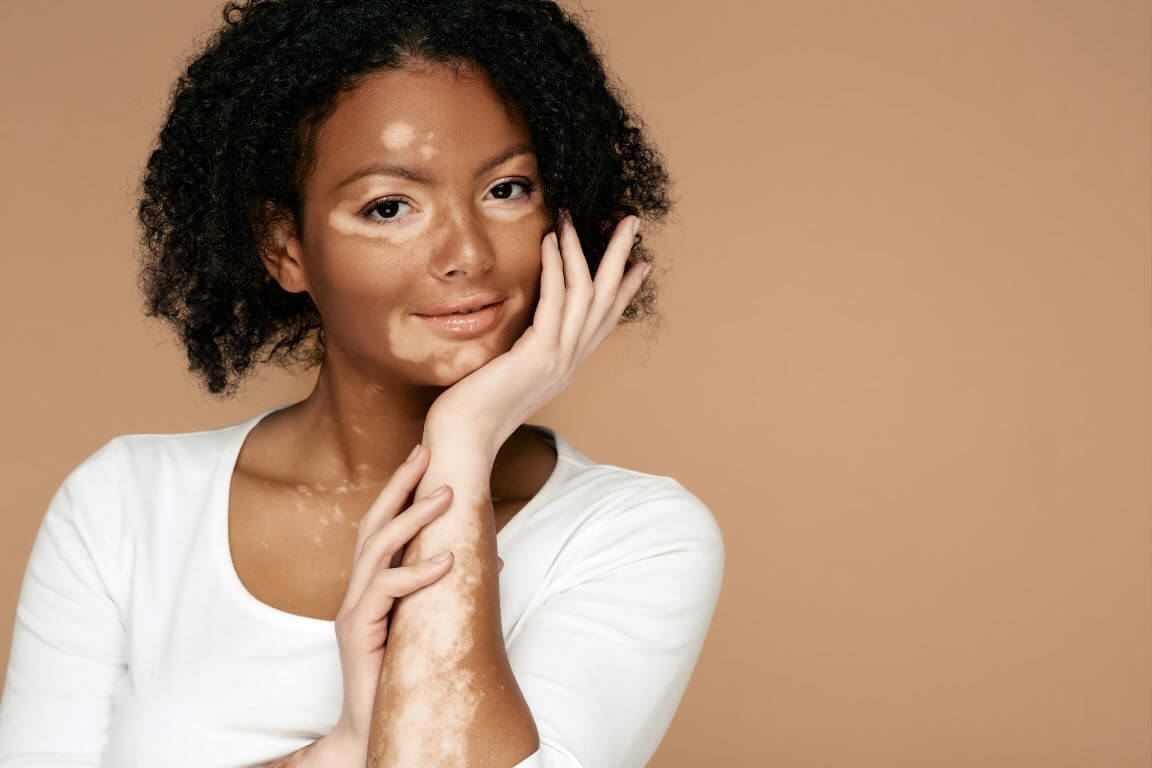Vitiligo is a relatively common skin condition that can impact anyone of any age or ethnicity. According to Dr. Lindsay Ackerman of U.S. Dermatology in Phoenix, Arizona, “While vitiligo is relatively well known, even those who struggle with this condition don’t always fully understand what vitiligo is and the underlying causes, making it that much more important to work with a dermatologist to understand the disease better, and receive treatment appropriate treatment.” In this blog, Dr. Ackerman discusses just what vitiligo is, what the treatment options are, and the importance of partnering with a dermatologist to manage vitiligo and other skin conditions.
What is Vitiligo?
Vitiligo is a disorder that causes loss of skin color (depigmentation) due to an autoimmune attack on skin cells called melanocytes, the cells that manufacture pigment (melanin) and give skin its color. Simply put, the melanocytes that are under attack are unable to manufacture melanin, which leads to a lightening of skin tone that progresses into a complete loss of pigment in certain body areas. Vitiligo is designated as non-segmental or segmental. Non-segmental vitiligo means that depigmentation develops on both sides of the body in a random fashion, although many times the depigmentation happens symmetrically. In distinction, people with segmental vitiligo see depigmentation develop only on one side of the body and often only in one area. Non-segmental vitiligo may continue to spread (and sometimes spontaneously improve) throughout a person’s life. Segmental vitiligo usually stabilizes within a year of symptom onset, and most people don’t develop any additional depigmented patches after the skin stabilizes. In rare cases, people may develop what’s called mixed-type vitiligo, which means they have both segmental and non-segmental vitiligo.
Causes of Vitiligo
Vitiligo is an autoimmune disease. It occurs when the body’s immune system attacks the melanocyte cells that create skin pigmentation. This autoimmune disease may be spontaneous, or hereditary. Statistically, people who have one or more family members with vitiligo are more likely to develop this condition. Vitiligo occurs when there are changes to a specific group of genes. Inheriting the genes related to vitiligo makes individuals more likely to experience a ‘trigger’ that will then turn on the gene and cause depigmentation to occur. Some common triggers of vitiligo include:
- Sunburns
- Injuries like cuts and burns
- Chemical skin damage
- Receiving immunotherapy
Symptoms and Diagnosis
In most cases, the depigmentation begins as small spots of lighter skin tone that grow and lighten over time. While vitiligo can appear on any part of the body, signs of vitiligo are most obvious and clinically problematic on the face, hands, arms, and feet. According to Dr. Ackerman, “Many people don’t know that vitiligo can impact the inside of the mouth, and it can even cause premature hair lightening. Understanding the versatile impact of vitiligo can help patients recognize the warning signs and seek treatment more quickly.”
The common symptoms of vitiligo include:
- Patches of lighter skin
- Lightening of skin inside the mouth and nose
- Lighter areas of skin that sunburn easily
- The depigmented skin may itch as patches spread
- Hair turning gray or white
- Hearing loss caused by the destruction of melanocyte cells in the ear
- Changing eye color
Available Treatment Options
First and foremost, Dr. Ackerman says, “Vitiligo does not require treatment for some people, as it is not indicative of a serious skin or internal-body health concern. The decision to seek treatment for vitiligo is very personal and may be very much related to the desire to improve the disfigurement caused by the disease. For my patients who wish to pursue treatment, I take time to talk through all of their options and help them understand the nature of the disease and what can be expected with treatment. We discuss those interventions that are less invasive and those that may be more invasive, depending upon both the severity of the disease and its impact. Regardless of the patient’s desired approach, it’s very important to establish trust and appropriate expectations, as with most cases of vitiligo, the treatment will be ongoing for some time.” Vitiligo treatment options are typically discussed for both restoring pigment and/or preventing depigmentation.
Color Restoration
- Topical medications – There are numerous prescription treatment options that can be applied to re-pigment skin. Potential medications include corticosteroids, tacrolimus ointment, pimecrolimus cream, calcipotriene with a corticosteroid, or JAK inhibitors.
- Laser treatment – CO2 lasers, erbium lasers, Fraxel, HALO, and other lasers can be used to re-pigment skin. The controlled dose of ultraviolet light promotes pigmentation, restoring natural skin tone.
- Phototherapy – Like laser therapy, the light waves are used to stimulate pigmentation and restore pigment to lighter areas of skin.
- Oral medications – Prednisone or other corticosteroids are infrequently prescribed to manage vitiligo. These prescription medications are designed to slow the growth of existing vitiligo patches and prevent the formation of new vitiligo patches.
- Skin graft – Mini-punch grafts use naturally pigmented areas of skin that are removed and transplanted to cover areas impacted by vitiligo.
- Cellular transplant – Melanocyte/keratinocyte transfers remove pigment cells from a healthy piece of skin and place them in the areas affected by vitiligo. Over several months, the introduction of the pigmented skin cells leads to re-pigmentation of the affected area.
Rarely, Dr. Ackerman says, “When vitiligo is very advanced, patients may elect to move forward with depigmentation treatment. This is only pursued when the most advanced treatments have been tried and aren’t effective or there is significant hardship related to maintaining results.”
Managing Vitiligo: Tips and Recommendations
When it comes to managing vitiligo on a daily basis, Dr. Ackerman says, “If you want to work toward re-pigmentation and create an even skin tone, your dermatologist can help you develop an ongoing care plan. However, one of the most important pieces of managing vitiligo is caring for the impact this condition often has on well-being, self-confidence, and mood. A dermatologist may not be the best resource for that, but they can certainly help you find the right support resources and be a strong ally and advocate. That includes putting patients in touch with support groups and other resources.”
While vitiligo is not usually something that can be controlled, some variables can be managed, including:
- Limiting sun exposure and always wearing sunscreen. Depigmented skin can burn more easily, and severe sunburns may cause vitiligo to spread.
- Being gentle with skin and doing your best to avoid injuries like cuts and burns. Skin injuries may cause vitiligo to spread. Tattoos can also trigger vitiligo because they damage the skin. You should do your utmost to limit skin damage and address injuries right away.
- Eat a healthy diet, get plenty of sleep, and exercise regularly to support a healthy immune system and prevent the spread of vitiligo.
- You can use makeup, skin dyes, and self-tanner to camouflage depigmented areas.
You Aren’t Alone in Managing Vitiligo
According to Dr. Ackerman, “At the end of the day, vitiligo should be addressed by integrating the specific needs of the patient and the knowledge of a board-certified dermatologist. Dermatologists understand the immunology and melanocyte biology involved in vitiligo, as well as the treatment options, prognosis, and psychosocial impact of the disease. While vitiligo may not cause problems with internal organs, the disease carries a large risk of significant adverse psychosocial impact secondary to disfigurement. It is critical that patients with vitiligo have a dermatologist who understands both the disease and its impact. Before you move forward with any in-office or at-home treatment, talk to your dermatologist about vitiligo and the treatments that suit your needs and skin health goals.”
Seek Advice from Trusted Professionals
If you or someone you know is grappling with vitiligo, seeking professional advice can make a difference. Reach out to our experts at U.S. Dermatology Partners for a personalized consultation. Our knowledgeable professionals will discuss your treatment options to ensure you feel confident and your skin stays healthy. We make getting started simple. Just take a few moments to complete our online scheduling request form. Once we hear from you, we’ll be in touch to finalize your visit.
Find a location near me
or


